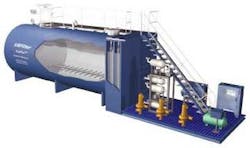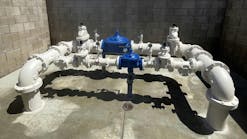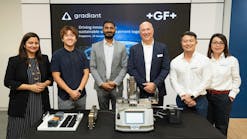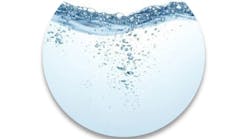When factory pre-assembled and skidded, the compact MBR systems provide high-quality treatment with many of the operational features of the most advanced municipal plants.
Click here to enlarge imageRecently, sophisticated membrane systems have allowed companies to develop more compact, pre-engineered systems. In remote locations or satellite plants, environmentally sensitive locations, or areas with small space requirements, membrane technology offers an ideal solution.
Satellite plants, a relatively new phenomenon, allow communities to increase treatment capacity without a disruptive and costly expansion. Recent membrane technology advancements allow cities to tap into existing sewer systems, sometimes called "sewer mining," and treat sewage on-site through a miniature wastewater treatment plant. Treated water can be used for water reuse applications such as irrigation, or can remain in the collection system and be channeled to the main treatment plant downstream.
These discreet systems reduce the costs of sending reclaimed wastewater through miles of distribution piping, decrease the load on a main treatment facility and delay costly expansions or permitting. Additional savings are realized because the plant does not require the same redundant equipment as an "end-of-the-line" plant.
One technology that is a good fit for remote or "satellite" wastewater treatment and water recycling is membrane bioreactors (MBR). MBRs typically have a small footprint, which allows these systems to be easily sited and to run with minimal operator attention, while providing high-quality effluent.
MBR Technology
The MBR process combines an aerobic biological process with an immersed membrane system. Cost effective and reliable, this separation technology is suited for a wide range of municipal and industrial wastewater applications. MBR systems can also provide advanced nitrogen and phosphorus removal to meet the most stringent effluent requirements.
There are many equipment variations, configurations and options that can be used with MBR systems, all of which are designed to provide the necessary treatment for each wastewater or water reuse project. The equipment selected depends on effluent requirements, operation and maintenance requirements, power consumption, future expansion and initial capital costs.
Within the MBR process, the biological process and membrane operating systems are located in separate tanks to optimize performance of the overall process and to simplify operation and maintenance. This unique combination eliminates the need for clarifiers, return sludge pumping, polishing effluent filters and maintenance normally associated with a conventional clarification process.
By eliminating clarifiers, the biological process can be designed and operated for high-rate wastewater treatment, rather than sludge settleability. The biological system can also be operated at much higher mixed liquor suspended solids (MLSS) concentrations (8,000 to 16,000 mg/L). This results in a more efficient biological process that increases solids retention time, reduces sludge yield and improves reactor efficiency for nitrification and denitrification.
High MLSS levels also mean that the plants can operate with shorter hydraulic retention times, allowing smaller reactor basins than with conventional treatment. Space requirements in the plant can be up to 50 percent less than with a conventional biological process. An existing conventional plant can be retrofitted with a membrane system, producing greater wastewater volumes in the same plant space, as well as higher quality water.
Operation of the treatment process is easily automated and can be controlled with a microprocessor such as a membrane monitoring system, which continuously monitors and records important operational parameters. A highly automated design helps operators meet stringent environmental requirements.
About the Author
Ed Jordan is the vice president of global membrane products for USFilter Memcor Products. He has more than 26 years of experience with membrane and membrane bioreactor technology. In the late 1970s, Jordan introduced the first commercial MBR wastewater systems into North America.



